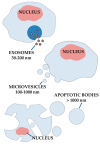Macrophage-Derived Extracellular Vesicles: A Promising Tool for Personalized Cancer Therapy
- PMID: 35740274
- PMCID: PMC9220135
- DOI: 10.3390/biomedicines10061252
Macrophage-Derived Extracellular Vesicles: A Promising Tool for Personalized Cancer Therapy
Abstract
The incidence of cancer is increasing dramatically, affecting all ages of the population and reaching an ever higher worldwide mortality rate. The lack of therapies' efficacy is due to several factors such as a delay in diagnosis, tumor regrowth after surgical resection and the occurrence of multidrug resistance (MDR). Tumor-associated immune cells and the tumor microenvironment (TME) deeply affect the tumor's progression, leading to several physicochemical changes compared to physiological conditions. In this scenario, macrophages play a crucial role, participating both in tumor suppression or progression based on the polarization of onco-suppressive M1 or pro-oncogenic M2 phenotypes. Moreover, much evidence supports the pivotal role of macrophage-derived extracellular vesicles (EVs) as mediators in TME, because of their ability to shuttle the cell-cell and organ-cell communications, by delivering nucleic acids and proteins. EVs are lipid-based nanosystems with a broad size range distribution, which reflect a similar composition of native parent cells, thus providing a natural selectivity towards target sites. In this review, we discuss the impact of macrophage-derived EVs in the cancer's fate as well as their potential implications for the development of personalized anticancer nanomedicine.
Keywords: cancer therapy; drug delivery; extracellular vesicles; macrophages; personalized nanomedicine.
Conflict of interest statement
The authors declare no conflict of interest.
Figures
References
-
- Giddings E.L., Champagne D.P., Wu M.-H., Laffin J.M., Thornton T.M., Valenca-Pereira F., Culp-Hill R., Fortner K.A., Romero N., East J. Mitochondrial ATP fuels ABC transporter-mediated drug efflux in cancer chemoresistance. Nat. Commun. 2021;12:2804. doi: 10.1038/s41467-021-23071-6. - DOI - PMC - PubMed
Publication types
LinkOut - more resources
Full Text Sources




